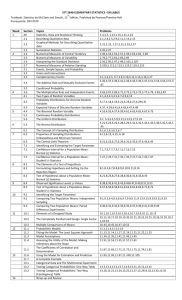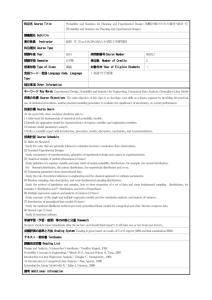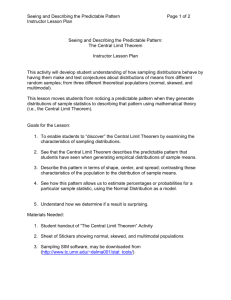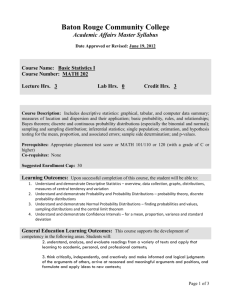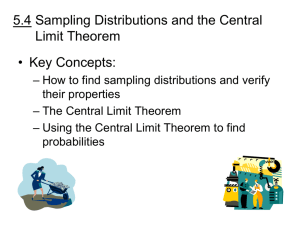Applying the central limit theorem Patrick Breheny March 8 Sampling distributions
advertisement
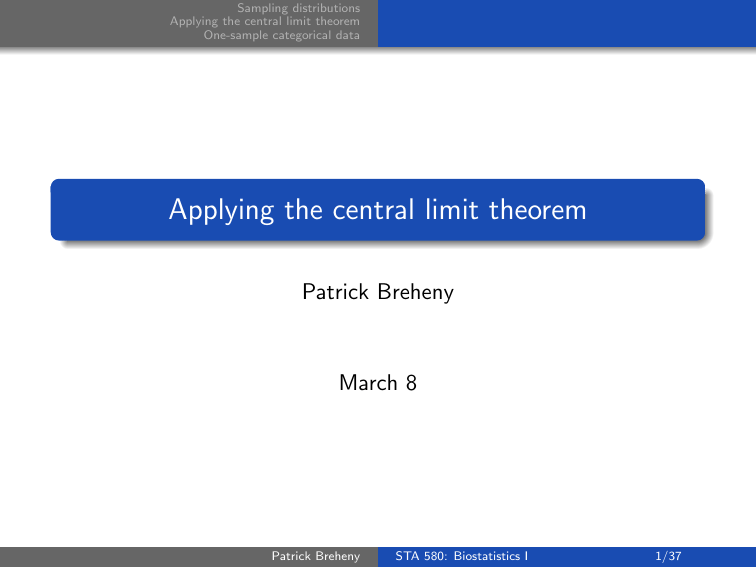
Sampling distributions Applying the central limit theorem One-sample categorical data Applying the central limit theorem Patrick Breheny March 8 Patrick Breheny STA 580: Biostatistics I 1/37 Sampling distributions Applying the central limit theorem One-sample categorical data Introduction It is relatively easy to think about the distribution of data – heights or weights or blood pressures: we can see these numbers, summarize them, plot them, etc. It is much harder to think about what the distribution of estimates would look like if we were to repeat an experiment over and over, because in reality, the experiment is conducted only once If we were to repeat the experiment over and over, we would get different estimates each time, depending on the random sample we drew from the population Patrick Breheny STA 580: Biostatistics I 2/37 Sampling distributions Applying the central limit theorem One-sample categorical data Sampling distributions To reflect the fact that its distribution depends on the random sample, the distribution of an estimate is called a sampling distribution These sampling distributions are hypothetical and abstract – we cannot see them or plot them (unless by simulation, as in the coin flipping example from our previous lecture) So why do we study sampling distributions? The reason we study sampling distributions is to understand how variable our estimates are and whether future experiments would be likely to reproduce our findings This in turn is the key to answering the question: “How accurate is my generalization to the population likely to be?” Patrick Breheny STA 580: Biostatistics I 3/37 Sampling distributions Applying the central limit theorem One-sample categorical data Introduction The central limit theorem is a very important tool for thinking about sampling distributions – it tells us the shape (normal) of the sampling distribution, along with its center (mean) and spread (standard error) We will go through a number of examples of using the central limit theorem to learn about sampling distributions, then apply the central limit theorem to our one-sample categorical problems from an earlier lecture and see how to calculate approximate p-value and confidence intervals for those problems in a much shorter way than using the binomial distribution Patrick Breheny STA 580: Biostatistics I 4/37 Sampling distributions Applying the central limit theorem One-sample categorical data Sampling distribution of serum cholesterol According the National Center for Health Statistics, the distribution of serum cholesterol levels for 20- to 74-year-old males living in the United States has mean 211 mg/dl, and a standard deviation of 46 mg/dl We are planning to collect a sample of 25 individuals and measure their cholesterol levels What is the probability that our sample average will be above 230? Patrick Breheny STA 580: Biostatistics I 5/37 Sampling distributions Applying the central limit theorem One-sample categorical data Procedure: Probabilities using the central limit theorem Calculating probabilities using the central limit theorem is quite similar to calculating them from the normal distribution, with one extra step: √ #1 Calculate the standard error: SE = SD/ n, where SD is the population standard deviation #2 Draw a picture of the normal approximation to the sampling distribution and shade in the appropriate probability #3 Convert to standard units: z = (x − µ)/SE, where µ is the population mean #4 Determine the area under the normal curve using a table or computer Patrick Breheny STA 580: Biostatistics I 6/37 Sampling distributions Applying the central limit theorem One-sample categorical data Example #1: Solution We begin by calculating the standard error: SD SE = √ n 46 =√ 25 = 9.2 Note that it is smaller than the standard deviation by a factor √ of n Patrick Breheny STA 580: Biostatistics I 7/37 Sampling distributions Applying the central limit theorem One-sample categorical data Example #1: Solution After drawing a picture, we would determine how many standard errors away from the mean 230 is: 230 − 211 = 2.07 9.2 What is the probability that a normally distributed random variable is more than 2.07 standard deviations above the mean? 1-.981 = 1.9% Patrick Breheny STA 580: Biostatistics I 8/37 Sampling distributions Applying the central limit theorem One-sample categorical data Comparison with population Note that this is a very different number than the percent of the population has a cholesterol level above 230 That number is 34.0% (230 is .41 standard deviations above the mean) The mean of a group is much less variable than individuals As Sherlock Holmes says in The Sign of the Four: “While the individual man is an insoluble puzzle, in the aggregate he becomes a mathematical certainty. You can, for example, never foretell what any one man will do, but you can say with precision what an average number will be up to. Individuals vary, but percentages remain constant. So says the statistician.” Patrick Breheny STA 580: Biostatistics I 9/37 Sampling distributions Applying the central limit theorem One-sample categorical data Procedure: Central limit theorem percentiles We can also use the central limit theorem to approximate percentiles of the sampling distribution: √ #1 Calculate the standard error: SE = SD/ n #2 Draw a picture of the normal curve and shade in the appropriate area under the curve #3 Determine the percentiles of the normal curve corresponding to the shaded region using a table or computer #4 Convert from standard units back to the original units: µ + z(SE) Patrick Breheny STA 580: Biostatistics I 10/37 Sampling distributions Applying the central limit theorem One-sample categorical data Percentiles We can use that procedure to answer the question, “95% of our sample averages will fall between what two numbers?” Note that the standard error is the same as it was before: 9.2 What two values of the normal distribution contain 95% of the data? The 2.5th percentile of the normal distribution is -1.96 Thus, a normally distributed random variable will lie within 1.96 standard deviations of its mean 95% of the time Patrick Breheny STA 580: Biostatistics I 11/37 Sampling distributions Applying the central limit theorem One-sample categorical data Example #2: Solution Which numbers are 1.96 standard errors away from the expected value of the sampling distribution? 211 − 1.96(9.2) = 193.0 211 + 1.96(9.2) = 229.0 Therefore, 95% of our sample averages will fall between 193 mg/dl and 229 mg/dl Patrick Breheny STA 580: Biostatistics I 12/37 Sampling distributions Applying the central limit theorem One-sample categorical data Example #3 What if we had only collected samples of size 10? Now, the standard error is 46 SE = √ 10 = 14.5 Now what is the probability of that our sample average will be above 230? Patrick Breheny STA 580: Biostatistics I 13/37 Sampling distributions Applying the central limit theorem One-sample categorical data Example #3: Solution Now 230 is only 230 − 211 = 1.31 14.5 standard deviations away from the expected value The probability of being more than 1.31 standard deviations above the mean is 9.6% This is almost 5 times higher than the 1.9% we calculated earlier for the larger sample size Patrick Breheny STA 580: Biostatistics I 14/37 Sampling distributions Applying the central limit theorem One-sample categorical data Example #4 What about the values that would contain 95% of our sample averages? The values 1.96 standard errors away from the expected value are now 211 − 1.96(14.5) = 182.5 211 + 1.96(14.5) = 239.5 Note how much wider this interval is than the interval (193,229) for the larger sample size Patrick Breheny STA 580: Biostatistics I 15/37 Sampling distributions Applying the central limit theorem One-sample categorical data Example #5 What if we’d increased the sample size to 50? Now the standard error is 6.5, and the values 211 − 1.96(6.5) = 198.2 211 + 1.96(6.5) = 223.8 contain 95% of the sample averages Patrick Breheny STA 580: Biostatistics I 16/37 Sampling distributions Applying the central limit theorem One-sample categorical data Summary n 10 25 50 SE 14.5 9.2 6.5 Interval (182.5,239.5) (193.0,229.0) (198.2,223.8) Width of interval 57.0 36.0 25.6 The width of the interval is going down by what factor? Patrick Breheny STA 580: Biostatistics I 17/37 Sampling distributions Applying the central limit theorem One-sample categorical data Example #6 Finally, we ask a slightly harder question: How large would the sample size need to be in order to insure a 95% probability that the sample average will be within 5 mg/dl of the population mean? As we saw earlier, 95% of observations fall within 1.96 standard deviations of the mean Thus, we need to get the standard error to satisfy 1.96(SE) = 5 SE = Patrick Breheny 5 1.96 STA 580: Biostatistics I 18/37 Sampling distributions Applying the central limit theorem One-sample categorical data Example #6: Solution The standard error is equal to the standard deviation over the square root of n, so 5 SD = √ 1.96 n √ n = SD · 1.96 5 n = 325.1 In the real world, we of course cannot sample 325.1 people, so we would sample 326 to be safe Patrick Breheny STA 580: Biostatistics I 19/37 Sampling distributions Applying the central limit theorem One-sample categorical data Example #7 How large would the sample size need to be in order to insure a 90% probability that the sample average will be within 10 mg/dl of the population mean? There is a 90% probability that a normally distributed random variable will fall within 1.645 standard deviations of the mean Thus, we want 1.645(SE) = 10, so 10 46 =√ 1.645 n n = 57.3 Thus, we would sample 58 people Patrick Breheny STA 580: Biostatistics I 20/37 Sampling distributions Applying the central limit theorem One-sample categorical data Hypothesis testing Confidence intervals The big picture Introduction We can use the exact same logic to carry out hypothesis tests for one-sample categorical data Consider our cystic fibrosis experiment in which 11 out of 14 people did better on the drug than the placebo Under the null hypothesis, the sampling distribution of the percentage who did better on one therapy than the other will (approximately) follow a normal distribution with mean p0 = 0.5 Patrick Breheny STA 580: Biostatistics I 21/37 Sampling distributions Applying the central limit theorem One-sample categorical data Hypothesis testing Confidence intervals The big picture The standard error What about the standard error? Recall that the standard deviation p of an individual outcome for the binomial distribution is p0 (1 − p0 ) Therefore, underpthe null hypothesis, the standard deviation is p p0 (1 − p0 ) = 1/4 = 1/2 Thus, the standard error is r p0 (1 − p0 ) n 1 = √ 2 n SE = Patrick Breheny STA 580: Biostatistics I 22/37 Sampling distributions Applying the central limit theorem One-sample categorical data Hypothesis testing Confidence intervals The big picture Procedure for a z-test To summarize this line of thinking intopa procedure: #1 #2 #3 #4 Calculate the standard error: SE = p0 (1 − p0 )/n Calculate z = (p̂ − p0 )/SE Draw a normal curve and shade the area outside ±z Calculate the area under the normal curve outside ±z Patrick Breheny STA 580: Biostatistics I 23/37 Sampling distributions Applying the central limit theorem One-sample categorical data Hypothesis testing Confidence intervals The big picture Terminology Hypothesis tests revolve around calculating some statistic from the data that, under the null hypothesis, you know the distribution of This statistic is called a test statistic, since it’s a statistic that the test revolves around In this case, our test statistic is z: we can calculate it from the data, and under the null hypothesis, it follows a normal distribution Tests are often named after their test statistics: the testing procedure we just described is called a z-test Patrick Breheny STA 580: Biostatistics I 24/37 Sampling distributions Applying the central limit theorem One-sample categorical data Hypothesis testing Confidence intervals The big picture The z-test for the cystic fibrosis experiment For the cystic fibrosis experiment, p0 = 0.5 Therefore, r p0 (1 − p0 ) n r 0.5(0.5) = 14 = .134 SE = Patrick Breheny STA 580: Biostatistics I 25/37 Sampling distributions Applying the central limit theorem One-sample categorical data Hypothesis testing Confidence intervals The big picture The z-test for the cystic fibrosis experiment (cont’d) The test statistic is therefore p̂ − p0 SE .786 − .5 = .134 = 2.14 z= The p-value of this test is therefore 2(1.6%) = 3.2% Patrick Breheny STA 580: Biostatistics I 26/37 Sampling distributions Applying the central limit theorem One-sample categorical data Hypothesis testing Confidence intervals The big picture Introduction: confidence intervals To find confidence intervals, the logic is similar, although the procedure is different Here, we’re not assuming that we know where the sampling distribution is centered – we don’t assume that p0 equals anything Instead, we’re trying to find a range of values for p0 that are plausible in light of observing p̂ – i.e., values of p0 such that if p0 were true, it wouldn’t be uncommon to see p̂ Patrick Breheny STA 580: Biostatistics I 27/37 Sampling distributions Applying the central limit theorem One-sample categorical data Hypothesis testing Confidence intervals The big picture Idea behind confidence intervals Essentially, this consists of sliding p0 around until p̂ no longer looks like it could reasonably have come from that sampling distribution: ^=p p 0 0.4 0.0 0.1 0.2 Density 0.3 0.4 0.3 Density 0.2 0.1 0.0 0.0 0.1 0.2 Density 0.3 0.4 0.5 2.5% 0.5 16% 0.5 50% ^ p Patrick Breheny ^ p p0 STA 580: Biostatistics I p0 28/37 Sampling distributions Applying the central limit theorem One-sample categorical data Hypothesis testing Confidence intervals The big picture The form of confidence intervals Let zx% be the value such that ±zx% contains the middle x% of the normal distribution (i.e., z95% = 1.96) Then in order to get an x% confidence interval with (100 − x)% of the errors split equally on both sides, we have to slide the sampling distribution zx% standard errors to the left of the mean, and then zx% standard errors to the right of the mean This will give us the two endpoints of our confidence interval Patrick Breheny STA 580: Biostatistics I 29/37 Sampling distributions Applying the central limit theorem One-sample categorical data Hypothesis testing Confidence intervals The big picture Procedure for finding confidence intervals Summarizing this line of thought, the central limit theorem tells us that we can create x% confidence intervals by: p #1 Calculate the standard error: SE = p̂(1 − p̂)/n #2 Determine the values of the normal distribution that contain the middle x% of the data; denote these values ±zx% #3 Calculate the confidence interval: (p̂ − zx% SE, p̂ + zx% SE) Patrick Breheny STA 580: Biostatistics I 30/37 Sampling distributions Applying the central limit theorem One-sample categorical data Hypothesis testing Confidence intervals The big picture Standard error Note that the standard error calculation is different here than it was for hypothesis tests In hypothesis tests, we specified a value of p0 , which in turn determined the standard error: r p0 (1 − p0 ) SE = n For confidence intervals, we don’t know p0 A reasonable thing to do, then, is to estimate SE based on p̂: r p̂(1 − p̂) SE = n Patrick Breheny STA 580: Biostatistics I 31/37 Sampling distributions Applying the central limit theorem One-sample categorical data Hypothesis testing Confidence intervals The big picture Example: Survival of premature infants Let’s return to our example from a few weeks ago involving the survival rates of premature babies Recall that 31/39 babies who were born at 25 weeks gestation survived The estimated standard error is therefore r .795(1 − .795) SE = 39 = 0.0647 Patrick Breheny STA 580: Biostatistics I 32/37 Sampling distributions Applying the central limit theorem One-sample categorical data Hypothesis testing Confidence intervals The big picture Example: Survival of premature infants (cont’d) Suppose we want a 95% confidence interval As we noted earlier, z95% = 1.96 Thus, our confidence interval is: (79.5 − 1.96(6.47), 79.5 + 1.96(6.47)) = (66.8%, 92.2%) Recall that our exact answer from the binomial distribution was (63.5%,90.7%) Patrick Breheny STA 580: Biostatistics I 33/37 Sampling distributions Applying the central limit theorem One-sample categorical data Hypothesis testing Confidence intervals The big picture Accuracy of the normal approximation Thus, we see that the central limit theorem approach works reasonably well here The real sampling distribution is binomial, but when n is reasonably big and p isn’t close to 0 or 1, the binomial distribution looks a lot like the normal distribution, so the normal approximation works pretty well Other times, the normal approximation doesn’t work very well: n=15, p=0.95 0.3 0.2 Probability 0.10 0.1 0.05 0.0 0.00 Probability 0.4 0.15 n=39, p=0.8 20 22 24 26 28 30 32 34 36 Patrick Breheny 38 10 11 STA 580: Biostatistics I 12 13 14 34/37 15 Sampling distributions Applying the central limit theorem One-sample categorical data Hypothesis testing Confidence intervals The big picture Example: Survival of premature infants, part II Recall that the Johns Hopkins researchers also observed 0/29 infants born at 22 weeks gestation to survive What happens when we try to apply our approximate approach to find a confidence interval for the true percentage of babies who would survive in the population? p SE = p̂(1 − p̂)/n = 0, so our confidence interval is (0,0) This is an awful confidence interval, not very close at all to the exact one we calculated earlier: (0%, 12%) Patrick Breheny STA 580: Biostatistics I 35/37 Sampling distributions Applying the central limit theorem One-sample categorical data Hypothesis testing Confidence intervals The big picture Exact vs. approximate intervals When n is large and p isn’t close to 0 or 1, it doesn’t really matter whether you choose the approximate or the exact approach The advantage of the approximate approach is that it’s easy to do by hand In comparison, finding exact confidence intervals by hand is quite time-consuming Patrick Breheny STA 580: Biostatistics I 36/37 Sampling distributions Applying the central limit theorem One-sample categorical data Hypothesis testing Confidence intervals The big picture Exact vs. approximate intervals (cont’d) However, we live in an era with computers, which do the work of finding confidence intervals instantly If we can obtain the exact answer, there is no reason to settle for the approximate answer That said, in practice, people use and report the approximate approach all the time Possibly, this is because the analyst knew it wouldn’t matter, but more likely, it’s because the analyst learned the approximate approach in their introductory statistics course and doesn’t know any other way to calculate a confidence interval Patrick Breheny STA 580: Biostatistics I 37/37
